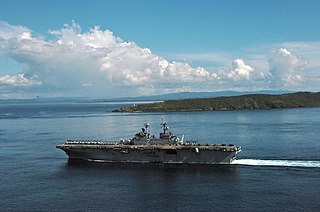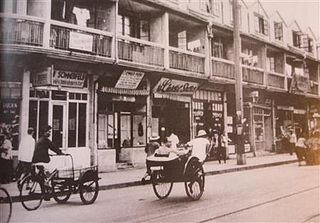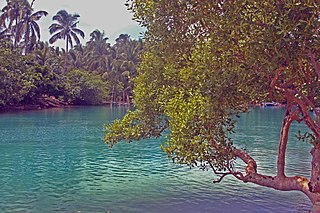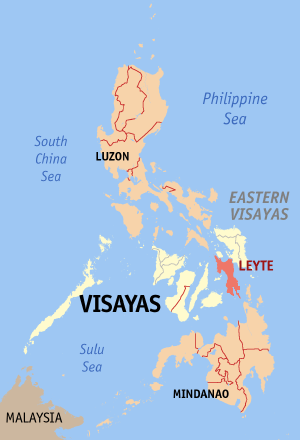
The International Refugee Organization (IRO) was an intergovernmental organization founded on 20 April 1946 to deal with the massive refugee problem created by World War II. A Preparatory Commission began operations fourteen months previously. In 1948, the treaty establishing the IRO formally entered into force and the IRO became a United Nations specialized agency. The IRO assumed most of the functions of the earlier United Nations Relief and Rehabilitation Administration. In 1952, operations of the IRO ceased, and it was replaced by the Office of the United Nations High Commissioner for Refugees (UNHCR).

Northern Samar, officially the Province of Northern Samar, is a province in the Philippines located in the Eastern Visayas region. Its capital is Catarman and is located at the northern portion of the island of Samar. Bordering the province to the south are the provinces of Samar and Eastern Samar. To the northwest, across the San Bernardino Strait is Sorsogon; to the east is the Philippine Sea of the Pacific Ocean and to the west is Samar Sea.

Eastern Samar, officially the Province of Eastern Samar, is a province in the Philippines located in the Eastern Visayas region. Its capital is the city of Borongan. Eastern Samar occupies the eastern portion of the island of Samar. Bordering the province to the north is the province of Northern Samar and to the west is Samar province. To the east lies the Philippine Sea, part of the vast Pacific Ocean, while to the south lies Leyte Gulf.

Samar is the third-largest and seventh-most populous island in the Philippines, with a total population of 1,909,537 as of the 2020 census. It is located in the eastern Visayas, which are in the central Philippines. The island is divided into three provinces: Samar, Northern Samar, and Eastern Samar. These three provinces, along with the provinces on the nearby islands of Leyte and Biliran, are part of the Eastern Visayas region.

The Polish diaspora comprises Poles and people of Polish heritage or origin who live outside Poland. The Polish diaspora is also known in modern Polish as Polonia, the name for Poland in Latin and many Romance languages.
The immigration history of Australia began with the initial human migration to the continent around 80,000 years ago when the ancestors of Aboriginal Australians arrived on the continent via the islands of Maritime Southeast Asia and New Guinea. From the early 17th century onwards, the continent experienced the first coastal landings and exploration by European explorers. Permanent European settlement began in 1788 with the establishment of a British penal colony in New South Wales. From early federation in 1901, Australia maintained the White Australia Policy, which was abolished after World War II, heralding the modern era of multiculturalism in Australia. From the late 1970s there was a significant increase in immigration from Asian and other non-European countries.

Guiuan, officially the Municipality of Guiuan, is a 2nd class municipality in the province of Eastern Samar, Philippines. It constitutes the southeastern extremity of Samar Island and some adjacent islands, surrounded by Leyte Gulf and the Philippine Sea, two major bodies of water that makes the town the surfing capital of the Visayas. According to the 2020 census, it has a population of 53,361 people, making it the most populous municipality in Eastern Samar and the second most populous administrative division in the entire province after the capital city Borongan.
Recorded Jewish history in the Philippines started during the Spanish period.

The Shanghai Ghetto, formally known as the Restricted Sector for Stateless Refugees, was an area of approximately one square mile (2.6 km2) in the Hongkou district of Japanese-occupied Shanghai. The area included the community around the Ohel Moshe Synagogue. Shanghai was notable for a long period as the only place in the world that unconditionally offered refuge for Jews escaping from the Nazis. After the Japanese occupied all of Shanghai in 1941, the Japanese army forced about 23,000 of the city's Jewish refugees to be restricted or relocated to the Shanghai Ghetto from 1941 to 1945 by the Proclamation Concerning Restriction of Residence and Business of Stateless Refugees. It was one of the poorest and most crowded areas of the city. Local Jewish families and American Jewish charities aided them with shelter, food, and clothing. The Japanese authorities increasingly stepped up restrictions, surrounded the ghetto with barbed wire, and the local Chinese residents, whose living conditions were often as bad, did not leave. By 21 August 1941, the Japanese government closed Shanghai to Jewish immigration.

White Russian émigrés were Russians who emigrated from the territory of the former Russian Empire in the wake of the Russian Revolution (1917) and Russian Civil War (1917–1923), and who were in opposition to the revolutionary Bolshevik communist Russian political climate. Many White Russian émigrés participated in the White movement or supported it. The term is often broadly applied to anyone who may have left the country due to the change in regimes.

The Shanghai Russians, a sizable part of the Russian diaspora, flourished in Shanghai, China between the World Wars. By 1937 an estimated up to 25,000 Russians lived in the city; they formed the largest European group there by far. Most of them had come from the Russian Far East, where, with the support of the Japanese, the Whites had maintained a presence as late as the autumn of 1922.
Immigration to the Philippines is the process by which people migrate to the Philippines to reside in the country. Many, but not all, become citizens of the Philippines.

Vietnamese boat people were refugees who fled Vietnam by boat and ship following the end of the Vietnam War in 1975. This migration and humanitarian crisis was at its highest in the late 70s and early 80s, but continued well into the early 1990s. The term is also often used generically to refer to the Vietnamese people who left their country in a mass exodus between 1975 and 1995. This article uses the term "boat people" to apply only to those who fled Vietnam by sea.
The ROCOR Canonical and Official Representation in the Philippines is a jurisdiction of the Eastern Orthodox Church under the Russian Orthodox Church Outside Russia, a semi-autonomous jurisdiction of the Moscow Patriarchate under Metropolitan Hilarion (Kapral), First Hierarch of the ROCOR. As of August 2013, there are four missions in the country.

The Guiuan Protected Landscape and Seascape, also known as the Guiuan Marine Reserve, is a protected area associated with the Guiuan Island Group which is located off the coast of the municipality of Guiuan on the eastern side of Leyte Gulf in the Philippines. The protected area consists of the following islands from within the group: Calicoan, Manicani, Suluan, Tubabao, Victory, Homonhon and other smaller islands and their surrounding reefs. It also includes the coastal area of mainland Guiuan in Eastern Samar covering a total area of 60,448 hectares. The land which now comprises the conservation area was previously declared as a Marine Reserve and Tourist Zone and was placed under the administration and control of the Philippine Tourism Authority in 1978. It was re-proclaimed and re-classified as a protected landscape/seascape in 1994 under the National Integrated Protected Areas System Act of 1992.

Between 1933 and 1945, a large number of Jews emigrated from Nazi Germany and German-occupied Europe. This exodus was triggered by the militaristic antisemitism perpetrated by the Nazi Party and by Germany's collaborators, ultimately culminating in the Holocaust. However, even before the genocide itself, which began during World War II, the Nazis had widely sponsored or enforced discriminatory practices—by legislation, in many cases—against Jewish residents, such as through the Nazi boycott of Jewish-owned businesses. Although Adolf Hitler and the German government were initially accepting of voluntary Jewish emigration from the country, it became difficult to find new host countries, particularly as the 1930s were marked by the Great Depression, as the number of Jewish migrants increased. Eventually, the Nazis forbade emigration; the Jews who remained in Germany or in German-occupied territory by this point were either murdered in the ghettos or relocated to be systematically exploited and murdered at dedicated concentration camps and extermination camps throughout the European continent.

Asian Australian history is the history of Asian ethnic and racial groups in Australia who trace their ancestry to Asia. The term Asian Australian, was first used in the 1950s by European Australians who wanted to strengthen diplomatic and trade ties with Asia for the benefit of the Australian community. The term was not originally used to describe or recognise the experiences of people of Asian descent living in Australia. It was only in the late 1980s and 1990s that the term "Asian Australian" was adopted and used by Asian Australians themselves to discuss issues related to racial vilification and discrimination. Today, the term "Asian Australian" is widely accepted and used to refer to people of Asian descent who are citizens or residents of Australia, though its usage and meaning may vary within the Asian Australian community.

Leyte–Samar Naval Base was a large United States Navy base in the Philippines on the Islands of Leyte, Samar and the San Pedro Bay. The base was built during World War II to support the many naval ships fighting and patrolling in the South West Pacific theatre of war as part of the Pacific War. A number of naval facilities were built on the east coast of Leyte island starting October 20, 1944. The first base was built at between the city of Tacloban and Anibong Point, a mile north of the city. Headquarters for the Seventh Fleet was built at Tolosa, 10 miles south of Tacloban on Leyte. The bases were on the large San Pedro Bay in Leyte Gulf which provided safe anchorage for many ships. Due to the lack of dry ground in Tacloban a second base was built on the east side of Leyte Gulf, on the south tip of Samar, on Calicoan Island and Tubabao Island. At Samar, a large Naval Depot was built to support the Pacific War. Samar was about 50 miles across Leyte Gulf from Tacloban. All construction was done by the Navy's Seabees.

The United States Navy held a number of bases in the Philippines Islands in the Pacific Ocean. Most were built by the US Navy Seabees, Naval Construction Battalions, during World War II. The US Naval Bases in Philippines were lost to the Empire of Japan in December 1941 during the Philippines campaign of 1941–1942. In February 1945 the United States Armed Forces retook the Philippines in the Battle of Manila in 1945. Before the captured US bases on Luzon were retaken the US Navy Seabees built a new large base, Leyte-Samar Naval Base, on the Philippine Island of Leyte, starting in October 1944.















